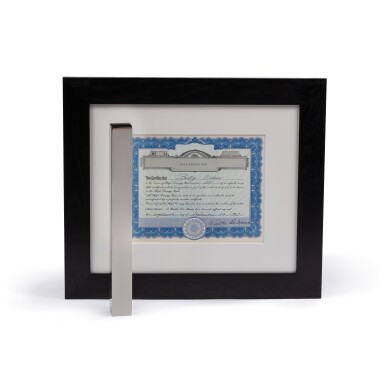Collection Loïc Malle: Only Time Will Tell
Collection Loïc Malle: Only Time Will Tell

Walter De Maria
High Energy Bar
Auction Closed
April 6, 05:08 PM GMT
Estimate
24,000 - 34,000 EUR
Lot Details
Description
Walter De Maria
1935 - 2013
High Energy Bar
signed, titled and dated 1966
steel
35,8 x 4 x 4 cm ; 14 x 1 9/16 x 1 9/16 in.
Executed in 1966, this engraving test sample bar is accompanied by a certificate signed by the artist in 1967, with the name Betty Asher.
_____________________________________________________________
Walter De Maria
1935 - 2013
High Energy Bar
signé, titré et daté 1966
acier
35,8 x 4 x 4 cm ; 14 x 1 9/16 x 1 9/16 in.
Exécutée en 1966, cette épreuve d'essai est accompagnée d'un certificat signé par l'artiste en 1967, portant le nom de Betty Asher.
Betty Asher (acquired directly from the artist in 1967 through Billy Wilder Gallery)
Franklin Parrasch, New York
Malle Collection, Paris
_____________________________________________________________
Betty Asher (acquis directement auprès de l'artiste en 1967 grâce à la Billy Wilder Gallery)
Franklin Parrasch, New York
Collection Malle, Paris
Documenta 4, 1968, Katalog 2, p.87, Illustrated
Art International, September 1968 and December 1968
Contemporary sculpture selections from the collection of the MOMA, New York, 1979, Illustrated
Walter de Maria, Rotterdam, 1984, Fig N°5 page 12, illustrated
T.Kellein, Walter De Maria, 5 Continents Sculpture, Staadtgalerie Stuttgart 1987-88, p. 65, illustrated
L.Nittve, JC Cooper, O.Granath, P Hulten, C.Lindqvist, M.Perniola, I.Rein, Walter De Maria. Two very large Presentations, Moderna Museet, Stockholm, May 1989, p. 83, illustrated
_____________________________________________________________
Documenta 4, 1968, Katalog 2, p.87, Illustré
Art International, septembre 1968 and décembre 1968
Contemporary sculpture selections from the collection of the MOMA, New York, 1979, Illustré
Walter de Maria, Rotterdam, 1984, Fig N°5 page 12, illustré
T.Kellein, Walter De Maria, 5 Continents Sculpture, Staadtgalerie Stuttgart 1987-88, p. 65, illustré
L.Nittve, JC Cooper, O.Granath, P Hulten, C.Lindqvist, M.Perniola, I.Rein, Walter De Maria. Two very large Presentations, Moderna Museet, Stockholm, mai 1989, p. 83, illustré
New York, Joan Washburn & Franklin Parrasch Gallery, Billy Wilder, A tribute, May 2005
Paris, Palais de Tokyo, Fresh Hell, Carte Blanche à Adam Mc Ewen, 19 October 2010 – 16 January 2011 (another example)
Koblenz, Ludwig Museum im Deutschherrenhaus, The Last Freedom: From the Pionneers of Land Art in the 1960's to Nature in Cyberspace, 16 April – 16 October 2011, catalogue, pp 66-67 (another example)
_____________________________________________________________
New York, Joan Washburn & Franklin Parrasch Gallery, Billy Wilder, A tribute, mai 2005
Paris, Palais de Tokyo, Fresh Hell, Carte Blanche à Adam Mc Ewen, 19 octobre 2010 – 16 janvier 2011 (autre exemplaire)
Koblenz, Ludwig Museum im Deutschherrenhaus, The Last Freedom: From the Pionneers of Land Art in the 1960's to Nature in Cyberspace, 16 avril – 16 octobre 2011, catalogue, pp 66-67 (autre exemplaire)
Walter De Maria’s ideas were close to “true minimalism”; he also exhibited together with minimalist artists such as Dan Flavin, Sol LeWitt, Robert Ryman, and Carl Andre at the Dwan Gallery in 1968-71.
In 1965 he started to produce serial objects made of stainless steel or aluminum, which he called “high energy bars”. He talked about them in an interview: “It was the idea that you could take a perfect cube, a perfect rectangle and [...] the notion that the ideas and lines were so perfect and so perfectly composed and self-contained that it was perfectly satisfying to look at the one object as a sculpture without having it confused with a lot of needless relationships. It was perfectly focused on itself and implied a lot more than it was.”
Energy Bar is probably the most minimal and esoteric piece De Maria ever produced. It was originally conceived “as part of a whole work of art to be known as the High Energy Unit” as it is stated in the certificate-contract between the artist and the owner. Further in, the certificate ads the following complementary information “All High Energy Bars in order to be operative and authentic must be accompanied by a properly executed certificate” bearing the name of the owner-purchaser and recorded in the archives of the artist.
_____________________________________________________________
Les idées de Walter De Maria étaient proches du « pur minimalisme »; il a également exposé avec des artistes minimalistes tels que Dan Flavin, Sol LeWitt, Robert Ryman et Carl Andre à la Dwan Gallery en 1968-71.
En 1965, il commence à produire des objets en série en acier inoxydable ou en aluminium, qu'il appelle « barres à haute énergie ». Il en parle dans une interview : « C'était l'idée que l'on pouvait prendre un cube parfait, un rectangle parfait et [...] la notion que les idées et les lignes étaient si parfaites et si parfaitement composées et autonomes qu'il était parfaitement satisfaisant de regarder cet objet unique comme une sculpture sans qu'il soit confondu avec un grand nombre de relations inutiles. Il était parfaitement concentré sur lui-même et impliquait beaucoup plus qu'il n'était. »
« Energy Bar » est probablement l'œuvre la plus minimale et ésotérique que De Maria n’ait jamais produite. Elle a été conçue à l'origine « comme une partie d'une œuvre d'art complète qui sera connue sous le nom de High Energy Unit », comme il est indiqué dans le certificat-contrat entre l'artiste et le propriétaire. Plus loin, le certificat ajoute l'information complémentaire suivante : « Toutes les barres High Energy, pour être opérationnelles et authentiques, doivent être accompagnées d'un certificat dûment exécuté » portant le nom du propriétaire-acheteur et enregistré dans les archives de l'artiste.
